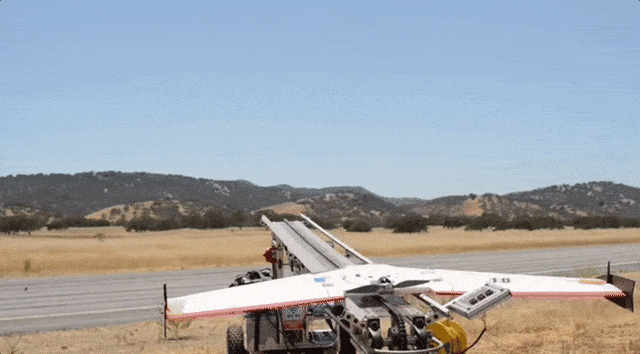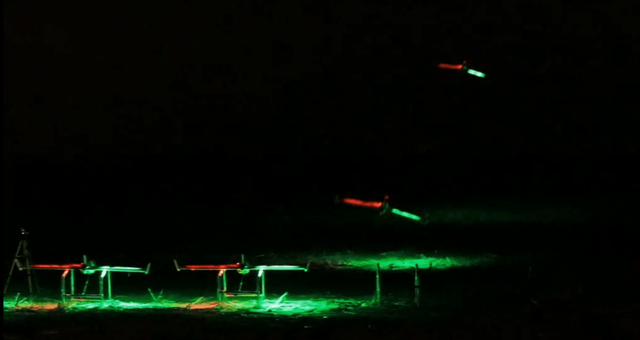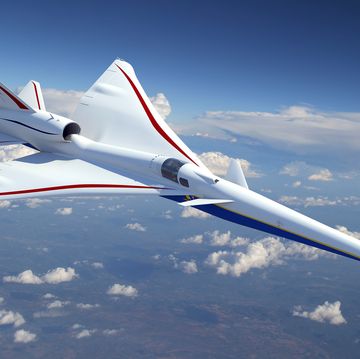Although large Predator and Reaper drones are the face of modern militaries, drone swarms—dozens of fixed-wing drones flying in coordinated formation— could be the future of unmanned combat. And if these aerobatic flock of drones are in our future, then the Chinese believe they're firmly in the lead after releasing a video last month of the largest swarm of fixed-wing drones ever flown.
As you'd expect, a drone swarm's advantage relies on the age-old truism of strength in numbers. Where one missile can knock out a multi-million dollar F-35 (and one mechanical failure can ground it), a swarm can take on casualties and failures and just keep going. If a swarm is big enough, it can overwhelm defenders by attacking with more drones than they can handle.
In the U.S., the Navy's LOCUST wants to field a swarm of attack drones that would cost collectively less than a single missile, while DARPA works away on its swarming Gremlins and the Air Force's develops miniature drones that can overwhelm air defenses.
"You have maybe 100 or 1,000 surface-to-air missiles," Col. Travis Burdine, the Air Force's division chief for unmanned aircraft, told Flightglobal in April. "But we're going to hit you with 10,000 [small drones]."
The key to a swarm is that the entire group acts as a single unit, but they're not centrally controlled. Instead, each member of the swarm uses software for coordination that mimics how flocks of birds and schools of fish behave. Currently, military drones like the Reaper are flown individually by a remote pilot, but a single operator could command any number of drones in a swarm. The operator issues a general instruction such as "search this area," and the swarm automatically co-ordinates its individual members to get the job done.
For years, the U.S. appeared to have a clear lead when it came to swarming drones. Last year the Advanced Robotic Systems Engineering Laboratory (ARSENL), claimed a new world record by launching a swarm of 50 drones at Monterey, California, all controlled by the same operator. But at the 11th China International Aviation and Aerospace Exhibition last month, state-owned China Electronics Technology Group Corporation (CETC) claimed to have shattered that record with a swarm of 67 drones flying together.
"Our swarming drone technology is the top in the world," CETC's Zhang Dengzhou told reporters.
The CETC video (above) shows the drones taking off and maintaining formation, and claims they are capable of networking together in flight and collaborating to carry out intelligence, surveillance and reconnaissance missions. These are key capabilities of a true autonomous swarm which can act without human oversight. But who knows how well the software handles real-world situations.
The final GCI-filled section of the video hints at future ideas for drone swarms, like a "saturation attack" where drones locate an enemy missile launcher and destroy it in a major assault.
The Chinese get more drones in the air because rather than having sophisticated chain-driven launchers like ARSENL (top GIF), their drones take off with what are essentially giant rubber bands (at around 40 seconds in). The number of launchers and the time it takes to reload was one of the limits on the U.S. exercise. It's also one of the reasons why the record for multi-copter swarming drones, which take off vertically without launchers, is much higher – Intel staged a 500-drone lightshow earlier this year.
The Chinese drones in the video have been identified as Skywalker X6s , made by the Skywalker Technology Co. based in Wuhan, China. Skywalker drones are popular among hobbyists as they can be bought in kit form for a few hundred dollars and fitted with custom electronics. ARSENL even used Skywalker X8 drones in their swarm. Skywalker drones are so popular because they're cheap, readily-available, and easy to customize. It's also why ISIS has adapted Skywalker drones to carry bombs.
The surprising thing is that Chinese swarming drones have come out of nowhere. So does this new announcement mean the Chinese are quietly edging ahead in swarm technology? China already makes portable kamikaze drones with explosive warheads, and effective swarming software would allow them to be deployed in large numbers, whether launched from the ground, sea, or air.
"Currently one man can control multiple drones in the system. In the future, one man will be able to control hundreds and thousands of drones," says Zhang.
Although militaries continue finding effective counters to small drones, some suggest that tactical swarms may rule the future battlefield. If that happens, then whoever has the best swarm wins, and China says they're in the lead. Although it's a hard claim to assess, it's a difficult one to ignore.
David Hambling is author of "Swarm Troopers: How small drones will conquer the world"















